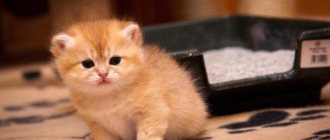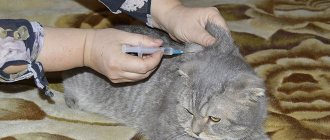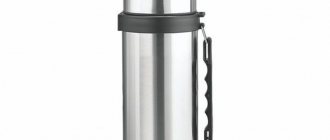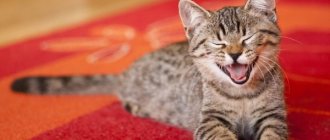How to remove cat smell in an apartment, what to do if a cat has marked in the house? Proven methods, recommendations and advice from experienced cat lovers will help you solve this rather complex problem and return clean air to your home.
Carpet detergents
The very first surefire way is to use a detergent special for carpeting. They are sold at any household chemical store. As a rule, this product is a concentrated liquid that must be diluted in a certain amount of water to a stable foam.
- In order to definitely get rid of cat urine and odor, this foam must be applied, lightly rubbing, into the desired area and allowed to settle.
- Then you need to take regular baking soda and pour it wet onto our stain. The detergent will remove the urine itself, and the baking soda will absorb the odor as it dries.
- Then use a vacuum cleaner to remove the dried soda. If necessary, this procedure can be repeated, although usually once is enough to get rid of a specific aroma.
Causes of cat urine odor
Cat urine consists of components responsible for color, consistency and odor:
- sticky urea, highly soluble in water;
- urochrome, which gives color;
- uric acid crystals.
The persistence of cat urine is due to the presence of colorless, odorless crystals, insoluble in water and alcohol. Unlike other components, which can be easily washed off with water, urinary crystals remain as a mine with a foul odor. Activation of an unpleasant aroma occurs due to contact with water, sweat, urine and when the air temperature in the room increases.
If your pet starts leaving puddles, you shouldn’t always blame shortcomings in upbringing; there are several reasons for such chaos.
There are many reasons why a cat began to leave smelly puddles:
- the tray is too high for the pet. It is important to choose the right latrine for your cat. An inconvenient toilet will be ignored by the beast;
- lack of trays with several pets. Also, the cat may not like the close proximity to someone else's litter box;
- the desire to mark territory is usually characteristic of young, uncastrated cats;
- inability to go to the toilet due to noise or excessive attention. Many cats are afraid of children or strangers in the house. Because of this, they seek solitude in other places;
- a dirty litter box is rejected by all cats;
- the age of the pet or its nervous condition. Older cats may no longer be able to get to the toilet or have problems urinating.
Vinegar
Everyone knows that vinegar can remove any unpleasant odors in the kitchen. So why don't we try it in case of unpleasant cat odor? To do this, the stain on the carpet must first be treated with a soap solution and only then poured with a solution of table vinegar diluted with water in a ratio of 1:3. In the first hour, the smell of vinegar will be persistent, but soon it will disappear, taking with it the unpleasant aroma of cat urine.
In this video, the owner will tell you how you can quickly clean up your pet’s puddle and at the same time eliminate unpleasant odors.
How to remove with special compounds?
When cleaning using improvised means does not lead to the desired result, and you need to remove the unpleasant smell of cat urine as quickly as possible (there is no time to re-use traditional methods), professional means will come to the rescue . TOP 3 proven, effective compositions:
Urine Destroyer
A product for removing stubborn stains and neutralizing urine odor is an effective product designed specifically for quickly solving the problem of cat “marks” in the house. Quickly neutralizes rather than masks the “traces” of the animal.
Ideal for all types of surfaces . Safe for use in children's rooms. The average cost is 880 rubles. (750 ml bottle).
Hartz Nodor Litter Spray
A scented product that eliminates the odors of cat waste. A distinctive feature is the ability to encapsulate odor molecules upon contact with urine. The product is absolutely safe for use in residential areas.
Non-toxic, does not cause allergies . The average cost is 550 rubles. (500 ml bottle).
Laina MS Spray
A product from a domestic manufacturer, effective in combating odors and marks of pets in the apartment. Suitable for all types of surfaces. Safe for animals . After use it leaves a pleasant aroma of lavender or fir. The average cost is 360 rubles. (750 ml bottle).
Before using any product, you must carefully study the instructions for use. Do not exceed the time of exposure of the product to the corroded surface, use the product in a larger volume than indicated by the manufacturer.
Stain remover "Vanish"
“Vanish” is also familiar to any housewife. It can be used for small rugs or carpets that can be taken outside to dry. To get rid of both an unsightly stain and an unpleasant odor at home, you simply need to wash the carpet with this product, rinse well, preferably under running water, and let it dry thoroughly. Most likely, this method is more suitable for those who live in a private house.
What to do for prevention?
It is possible to prevent the appearance of an unpleasant cat odor in the apartment if you adhere to certain rules:
- We place the tray only in secluded places. The cat always looks for corners hidden from prying eyes for the toilet.
- We treat the sites of potential “acts of revenge” with special products - cat bleaches. Particular attention should be paid to places where shoes are stored, the rug in front of the bed, and in the bathroom.
- Decorate flower pots with orange peels or pine cones. Cats love to make toilets in flowerpots; pine cones and oranges discourage the pet from marking its territory in this way.
- We change cat litter regularly. The domestic cat is an extremely clean animal that will never defecate in a dirty litter box.
A cat is an animal that does not tolerate violence. In response to beatings and humiliation, the cat will take revenge (mark its territory).
Dry mustard
Even the simplest mustard powder can be used to remove cat urine.
- In order to remove stains and odor, you need to dilute the mustard powder with water to a paste consistency.
- Then this mass is applied directly to the desired place and allowed to sit for a while so that it dries a little.
- Then, using a wet rag, the mush is collected, and finally the area is wiped dry.
- Remaining mustard particles can be collected with a vacuum cleaner.
Reasons why a cat doesn't go to the litter box
Before you eliminate the cat smell in your apartment once and for all, you need to figure out why your pet doesn’t go to the litter box.
- The animal does not like the toilet. For example, you need to take into account that the size of the tray should be at least one and a half times longer than the cat itself.
- You should choose a darkened and secluded place, because the cat needs peace. There is no need to place several trays side by side, animals cannot stand this.
- Unsanitary conditions. Cats have an excellent sense of smell, they are very clean, so a litter box that emits a stench will become an insurmountable obstacle to the animal going there. You need to clean the toilet with special means.
- Fright may cause your pet to become stressed. From this, he begins, calming down, to mark his territory, splashing drops of urine anywhere.
- Revenge on the owner - a puddle in shoes or on clothes can mean that the cat is offended. It is worth showing patience and making amends to your pet. You cannot punish a kitten for this, because the situation will only get worse.
- Reaction to new odors that are perceived as a threat.
- Animal disease. It is more common in older males, and in young males, incontinence can mean a serious illness.
- An uncastrated cat marks its territory, thereby demonstrating its superiority in the house, and the cat attracts the male in this way. These marks smell stronger than plain urine. Only a castrated cat and a sterilized female will not mark corners, so there is only one way out - take your pet to the veterinarian.
A more complicated method
For this option, you need to get vinegar, baking soda, detergent and hydrogen peroxide. But check in advance somewhere at the edge of the carpet to see if its colors will react with hydrogen peroxide.
- In order to get rid of a stain and an unpleasant “aroma”, you must first pour vinegar on this place and wait until it dries. It’s worth warning right away that the cat smell may intensify, be patient.
- Then pour baking soda onto the stain.
- Then you need to prepare a solution. We take water and hydrogen peroxide in equal proportions, as well as a little detergent, you can use “Fairy” or any other that is in the house.
- The prepared solution must be placed in a spray bottle and sprayed over the soda.
- After everything is dry, you need to vacuum the area.
What harm can it cause
Regular cleaning of the apartment, bathroom and furniture is an important condition for human health. It is especially important to pay more attention to hygiene if there are animals or small children in the house. Untimely removal of feces can lead to a deterioration in the general condition of household members, the spread of bacteria, infection with helminths and infections.
Hydrogen sulfide
One of the dangerous substances released by decomposing feces is hydrogen sulfide. It is a gas that has no color but has a disgusting, pungent odor of a rotten egg. Hydrogen sulfide is poisonous and has a toxic effect on humans and animals. At low concentrations, the gas has no significant harmful effect. If the smell is strong, a person's respiratory receptors are blocked and he stops feeling the stench. The process of intoxication begins, causing dizziness, nausea, loss of consciousness, and headaches. Hydrogen sulfide poisoning often leads to the development of chronic diseases of the respiratory tract and skin.
Ammonia and carbon dioxide
Ammonia and carbon dioxide are other derivatives of fecal fermentation. Gases in high concentrations are dangerous to humans. The mucous membranes of the eyes and respiratory tract are the first to be affected. Ammonia can cause severe burns if it comes into contact with skin. Inhaling carbon dioxide causes headaches, shortness of breath, and nausea.
Sometimes exposure to substances in higher concentrations forces a person to see a doctor.
Bacteria
The feces of warm-blooded animals and humans are a natural environment for the development of Escherichia coli bacteria. In addition, most domestic animals suffer from the presence of worms, many of which are parasitic in humans. Therefore, any contact with feces or incomplete removal can cause infection and the development of diseases of the digestive system.
See also
TOP 20 remedies and methods on how to remove the smell of urine from the sofa at home
Video “All possible ways to get rid of an unpleasant odor”
In this video you can learn how to eliminate that unpleasant cat urine smell.
Sorry, there are no surveys available at this time.
Was this article helpful?
Thank you for your opinion!
The article was useful. Please share the information with your friends.
Yes
No
X
Please write what is wrong and leave recommendations on the article
Cancel reply
Rate the benefit of the article: Rate the author ( 2 votes, average: 4.50 out of 5)
Discuss the article:
Features of working with clothes
It's easy to remove fecal smell from clothes. Before washing, it is important to consider what fabric it is made of.
Methods:
- rinse in a solution of 9% vinegar or citric acid;
- soak for 10 minutes in a solution of table salt;
- rinse in a solution of ammonia and salt.
Do not wipe the stain with wet wipes or try to mask the smell with others. Typically, the opposite effect occurs and the fabric begins to smell like a mixture of aroma and feces.
Privacy Policy
Introduction
We are committed to respecting the personal information of visitors to our site. This Privacy Policy explains some of the measures we take to protect your privacy.
Confidentiality of personal information
“Personally identifiable information” means any information that can be used to identify an individual, such as name or email address. Use of private information. Personally identifiable information collected through our site is used by us, among other things, for the purposes of registering users, maintaining and improving our site, tracking policies and site usage statistics, and for purposes authorized by you.
Disclosure of private information...
We employ other companies or are affiliated with companies that provide services on our behalf, such as processing and delivering information, posting information on this site, delivering content and services provided by this site, and performing statistical analysis. To enable these companies to provide these services, we may share personal information with them, but they will only be permitted to receive the personal information they need to provide the services. They are required to keep this information confidential and are prohibited from using it for other purposes. We may use or disclose your personal information for other reasons, including if we believe it is necessary to comply with the law or court orders, to protect our rights or property, or to protect the personal safety of users of our site or members of the general public. , to investigate or take action regarding illegal or suspected illegal activity, in connection with a corporate transaction such as a divestiture, merger, consolidation, sale of assets or in the unlikely event of bankruptcy, or for other purposes consistent with your consent. We will not sell, rent or lease our user lists with email addresses to third parties.
Access to personal information.
If, after providing information to this site, you decide that you do not want your personal information to be used for any purpose, please contact us at the following address: [email protected] en
Our Practices Regarding Non-Personal Information.
We may collect non-personal information about your visit to the site, including the pages you view, the links you click, and other activities in connection with your use of our site. In addition, we may collect certain standard information that your browser sends to any website you visit, such as your IP address, browser type and language, time spent on the site, and the address of the website in question.
Using bookmarks (cookies).
A cookie is a small text file placed on your hard drive by our server. Cookies contain information that can later be read by us. No data collected by us in this way can be used to identify a visitor to the site. Cookies cannot be used to run programs or infect your computer with viruses. We use cookies to monitor the use of our site, collect non-personal information about our users, store your preferences and other information on your computer in order to save you time by eliminating the need to repeatedly enter the same information, and to displaying your personalized content on your subsequent visits to our site. This information is also used for statistical studies aimed at adjusting content according to user preferences.
Aggregated information.
We may combine in a non-identifiable format the personal information you provide and the personal information provided by other users, thereby creating aggregate data. We plan to analyze aggregated data primarily for the purpose of tracking group trends. We do not link aggregated user data to personally identifiable information, so aggregated data cannot be used to contact or identify you. Instead of using actual names, we will use usernames during aggregate data creation and analysis. For statistical purposes and to track group trends, anonymous, aggregated data may be provided to other companies with whom we interact.
Changes to this Privacy Statement.
We reserve the right to make changes or additions to this Privacy Policy, in part or in whole, from time to time. We encourage you to periodically review our Privacy Policy to stay informed about how we protect your personal information. The most current version of the Privacy Policy can be viewed by clicking on the “Privacy Policy” hypertext link located at the bottom of the home page of this site. In many cases, when we make changes to the Privacy Policy, we will also change the date at the beginning of the Privacy Policy, but we may not provide you with other notice of changes. However, if there are material changes, we will notify you either by prominently posting a prior notice of such changes or by directly sending you a notification via email. Your continued use of and access to this site constitutes your acceptance of such changes.
Stories from cat owners
Nikita: “Our cat is sterilized and we didn’t have any problems with the smell of urine before, but a couple of months ago a terrible smell of ammonia began to come from the litter box. At first we thought that the new food was to blame. But after a visit to the veterinarian, it turned out that our girl had an inflamed bladder. The strong odor was caused by this particular disease. The veterinarian prescribed us a course of antibiotics (Monural), the cat recovered, and the smell disappeared.”
Anton: “We took the cat to the veterinarian without a carrier, he puffed up on the leather car seat in fright. I removed the smell with hot mineral water (Borjomi) and salt. I watered it with mineral water, sprinkled it with salt and rubbed it all. After treatment, I thoroughly washed the interior and seats. In order not to spoil the leather, you need to try this mixture on a small piece of upholstery.”
Maria: “I removed a stain from the sofa with a solution of potassium permanganate. They say that a vinegar solution works well - I was afraid of ruining the upholstery. My sofa is brown, potassium permanganate did not leave any stains on it. I wouldn’t experiment like that with light furniture.”
A satisfied face of a furry asshole and a pile in the middle of the corridor - this situation is familiar to almost every owner. As a result, you have to clean up after your pet, and then look for ways to get rid of the smell of cat poop. Due to the specific composition of feces, the stench spreads throughout the entire room: it seems that it is being eaten into furniture and interior items.
However, you shouldn’t put on a gas mask and resign yourself to the situation or even look for a new owner for the furry intruder: Dufta has collected tips that will help remove the smell from cat feces and prevent the situation from reoccurring.











